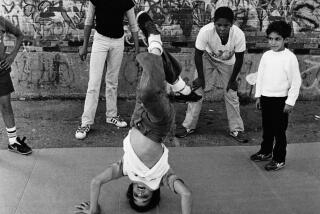Rope Jumpers Try to Lasso New Devotees
- Share via
WASHINGTON — This is a sport for cheapskates. Equipment costs $10.
That investment, plus a good pair of shoes, is about all a person needs to start jumping rope. Enthusiasts say workouts can improve heart rate, breathing, endurance, upper and lower body strength, and coordination.
Just the same, although it’s been done by everyone from elementary school children to world champion fighters, jumping rope is still trying to lasso participants.
“Historically, people have seen it as a wonderful exercise, but they have come to see it as boring and monotonous,” said Martin Winkler, a partner in FreeStyle Roping, a jump rope exercise program based in Burbank.
FreeStyle Roping and similar regimens are showing some fancy footwork in promotion, with exercise videos and exhibitions. Backers want to demonstrate that jumping rope is more than bouncing up and down over and over.
Rope-jumping enthusiasts are also reaching out to kids through programs such as Jump Rope for Heart, backed by the American Heart Assn. and the American Alliance for Health, Physical Education, Recreation and Dance. The AHA and the physical education teachers’ group got an estimated 1.8 million students jumping during the 1995-96 school year, said AHA spokesman Greg Hunicutt. The program doubles as a part of the physical education curriculum and an AHA fund-raiser.
There also are budding leagues of rope jumpers for exhibitions and competition.
This isn’t news to kids who do double dutch chants as their friends swing two ropes in opposite directions. But jumping rope could be a different experience for adults who got out of step over the years.
“When I was younger, I would do double dutch,” said Mindy Mylrea of Santa Cruz, Calif., an aerobics champion who has been giving workshops for two years on jumping. “Most people think of it as a child’s sport, but it is really an adult sport.”
Drawing on her aerobics background, Mylrea came up with about 40 different steps that can be done under a rope.
People can jump rope as a stand-alone--or, perhaps, jump-alone--activity. Or they can mix it with other kinds of exercise. FreeStyle Roping offers rope jumping as an aerobic class in itself. Mylrea intersperses five one-minute rope-jumping sessions in aerobics classes. “It’s like a spice,” she said. “You add it to anything else.”
The difference in approach affects the workout. FreeStyle Roping lets jumpers cut themselves some slack by swinging the rope to the side when they are no longer up to hopping over it. Mylrea goes for the intense, anaerobic burn.
Rope-jumping experts recommend the activity as great training for any sport involving quick, intense leg moves, such as basketball, tennis and the martial arts, said Richard Cotton, editor in chief of FitnessMatters, an American Council on Exercise publication.
But rope jumping is good on its own, Cotton said. “One should really get in shape to jump rope rather than jump rope to get in shape,” he said.
*
Beginners must learn proper form and control. Starting jumpers commonly leap when they should skip, Winkler said. “As a result of not using proper technique, they end up using a tremendous amount of excess energy, and get discouraged and give up,” he said. “The key is only leaving the ground a few inches.”
It’s also important to keep the knees soft for impact cushioning, and to stay on the balls of your feet and your toes, Cotton said.
Rope jumping has not developed its own shoe style, but aerobics and cross-training shoes should work, if they have good cushioning and side support, Mylrea said.


